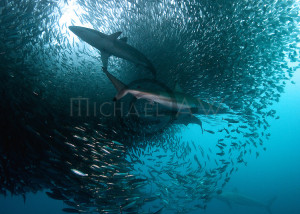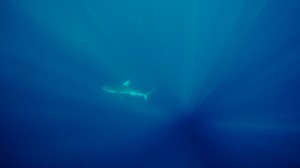I came all the way down from Germany to the East coast of South Africa to watch one of the world’s top wildlife spectacles on Earth: The Sardine Run!
Every year millions of sardines migrate from the cold waters of the south of South Africa to the warmer waters, just along South Africa’s east coast. The sardines are followed by hungry predators. Thousands of dolphins, sharks, sea birds, whales and even seals enjoy this fishy banquet. To protect themselves from this attack, sardines form into giant balls called ‘bait balls’ which can measure as large as 30 meters in diameter. The probability of getting eaten by a predator is lower when they form a big group than swimming alone. While bait balls are difficult to get up close and personal with (they dissolve easily), the predators that abound during this time in these waters make for some truly spectacular diving opportunities.

I came thanks to the worldwide famous underwater photographer Michael Aw, the director of Ocean Geographic Magazine. He has been coming here for the last 10 years and, as you can see above, he has a number of incredible photos of this stunning phenomenon of nature. The captain he chooses year after year to run his tour is Walter Bernardis, an underwater legend and one of the pioneers of the sardine run tours. He is able to find the bait balls and put the divers in the perfect time and position to enjoy this predator behaviour from the best possible angle. After listening to his stories one can’t imagine how excited I was to see this spectacle with my own eyes!! As a diver and biologist, it was a dream coming true!
But then reality slapped me right in the face. 10 days looking for sardines with the most experienced crew in the world and we found nothing. Just predators looking for them too, blue water and lots of hope fading away. I was frustrated, sad and full of questions. Why is it so hard to find the bait balls? Where are all the sardines? Why is it that we could see all the predators but not the prey?

The answers I got from Michael and Walter were heartbreaking. The sardine run has been decreasing year after year. Every season is worse. I feel very disappointed for not having seen the predation of the sardines by sharks, dolphins, birds and whales, and this is when I realise there is a bigger predator preying on the sardines: the fishermen.
Down south of the coast of South Africa, there is a massive fishery activity. It seems that the growth of the sardines fishery industry down south and the sightings of the sardines up north are inversely proportional. This means than probably there is a relation between the fishing that is happening in the south and the low success rate of the sardine run tours.
After hearing this I decided to go to the south to see by my own what is happening to the sardines. Therefore, next week I will be in Port Elizabeth learning about the sardines overfishing and what can I do to solve this problem.
To be continued…
PS: Please watch the amazing video of the North America Rolex Scholar 2010, Josh Stewart, who was also invited by Michael Aw and Walter Bernardis 4 years ago. We had the same experience with very different results. If we compare them, we can have an idea of what overfishing is doing to our oceans